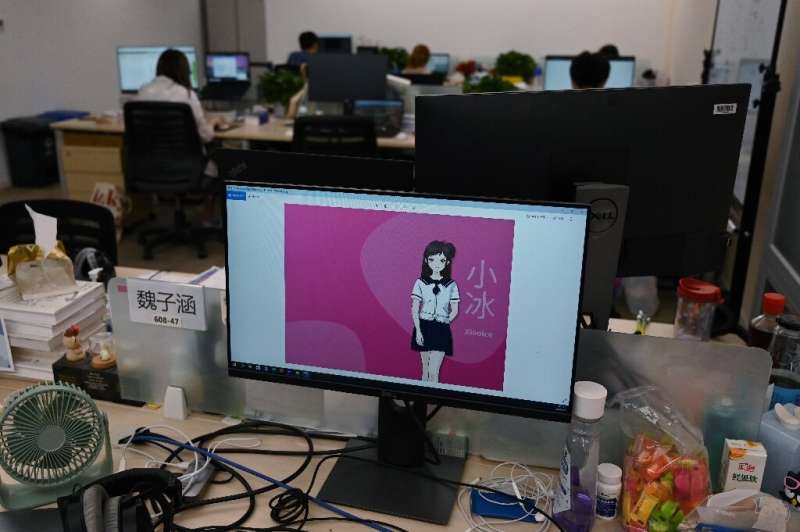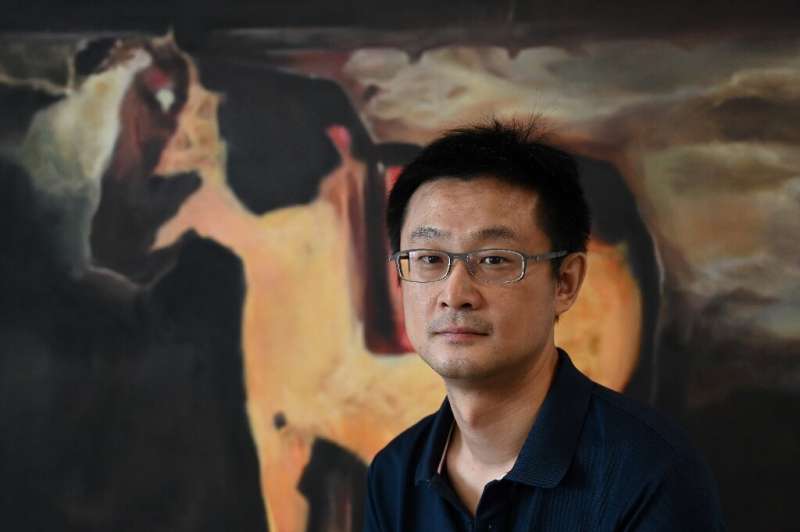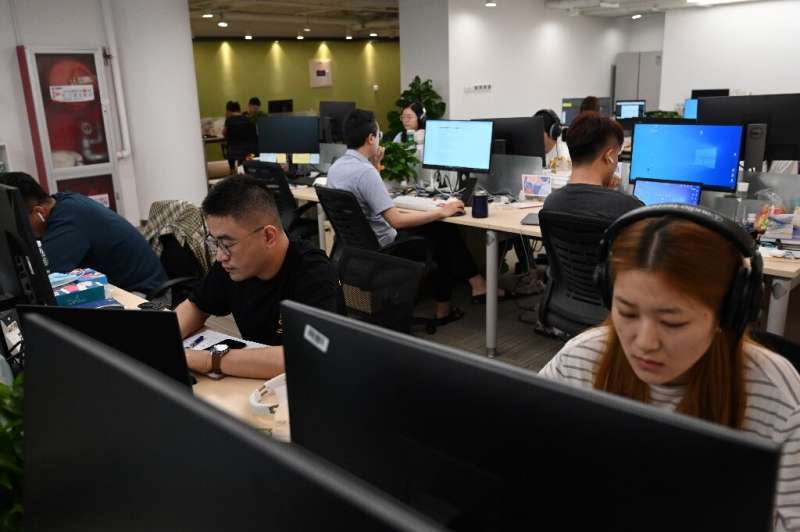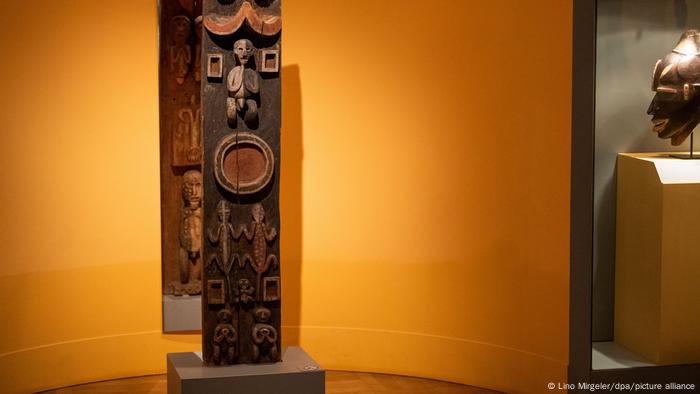Mohanad Hashim - BBC News
Sat, January 22, 2022

Anti-coup demonstrators reflected in the glasses of a protester in Khartoum, Sudan - Thursday 20 January 2022
"Did I just survive a massacre?" asked a young Sudanese man when he answered my call not long after security forces had opened fire on protesters in downtown Khartoum.
Known by his Twitter name Bashy, he told how one of seven people had died last Monday afternoon in the capital.
"I was filming the protesters and walking when a bullet penetrated his chest; he died in front of me. That could have been me!"
In his mid-twenties, and usually with a smile on his face, Bashy has been protesting on the streets for the past three months.
Like many of his contemporaries, he is furious that the military seized power last October, just over two years into an agreement between the generals and a civilian coalition to share power.
Life had been improving and the economic crisis easing as civilian Prime Minister Abdalla Hamdok brought Sudan in from the cold following sanctions imposed on the country during the long rule of Omar al-Bashir, accused of using the country to sponsor terrorism.

The economic gains of the two-year power-sharing transition have been forfeited by the coup
The former president's military allies ousted him in April 2019 in the wake of mass protests, but they then showed their reluctance to share power with those on the streets when they turned their guns on them in a devastating massacre two months later.
The outcry that followed forced the generals to agree to the transition - but as many suspected, the military was never happy with the arrangement, and the latest coup, they say, has proved them right.
'Vicious cycle'
Bashy, who has been on the front lines of the recent demonstrations documenting the rallies and marches on his social media feeds, says those on the neighbourhood committees co-ordinating the fightback on the streets are mainly young.

More than half of Sudan's population have largely only known life under Omar al-Bashir
In fact it is estimated that 61% of Sudan's population is under the age of 25 and they are fed up with what Bashy terms "strong-man rule".
It is a generational conflict with the young wanting a more equitable, peaceful, and democratic future.
"We are different to previous generations," says Bashy.
"We want to stop the cycle, this vicious cycle of military coups and authoritarianism. That is why we protest - because we wish to see the end of this cycle."
Loyalists reinstated
The protesters feel they have legitimacy on their side - and the junta has indeed been dealt a blow by the resignation earlier this month of Mr Hamdok.
In the aftermath of the coup he was put under house arrest - but then signed a new deal with the generals - something his civilian coalition, the Forces for Freedom and Change (FFC), rejected.

Gen Abdel Fattah al-Burhan's attempt to bring the civilian PM on board has backfired
He only lasted six weeks before realising he could not work without the political backing of the FFC.
Some of the economic reforms he brought in - applauded by the international community - were painful for everyone, but his attempts to dismantle the old guard's hold on the economy also ruffled feathers.
Indeed, this week, Sudan's military ruler Gen Abdel Fattah al-Burhan finally appointed a caretaker administration, which includes some of those Bashir loyalists, to steer the country to elections.
Nidal, whose name has been changed to protect her identity, is a seasoned protester - first taking to the streets during the Arab spring when people began to brave the streets.

More than 70 people have died and thousands have been injured since October
She believes the military's harsh treatment of the protesters - more than 70 have died so far - is forcing those organising the demonstrations to become more tactical - or more cohesive.
"You can sense the military is doing us a favour - the more of us they kill, helps us the people to come together, reshape our nationalist sentiment and foster a new patriotism for building a new country."
Since independence the armed forces have monopolised any sense of patriotism.
But their actions - in particular those of the former paramilitary unit, the Rapid Support Forces led by Mohamed Hamdan "Hemeti" Dagolo - and their role in the massacre of June 2019 means much of the respect they were once afforded has been lost by young Sudanese.
For Nidal, the demonstrations have had a devastating effect on her family: one of her 18-year-old cousins was shot dead by soldiers in December.
When I spoke to her late one evening this week she had just been to various barricades in Khartoum to round up her many other cousins to check they were all safe.
Yet the situation has just made them all the more determined - because they feel they can really make a difference.
"I am ready to die," she told me.
Trust broken
In mid-January, the junta announced that it was setting up a counter-terrorism force to deal with the security challenges posed by the protests - which are also hitting the economy.
Viewing peaceful protesters as terrorists is seen by many as taking a leaf out of the Bashir-era rule book.

The barricades are organised by neighbourhood committees - and some are blocking key roads
In their statements, the authorities note how many policemen are injured on duty during the nationwide protests - with little regard to the death of demonstrators.
This week, the death of a police brigadier general has been blamed on the protesters, but activists dispute this and say it is being used as an excuse to unleash yet more force.
And this week's violence came after an Al Jazeera channel that had been carrying live feeds of the demonstrations and rallies was banned.
The crackdown on media freedoms has become unrelenting: journalists have been beaten and assaulted, media offices attacked and international media barred.
There has been a flurry of diplomatic activity to break the stalemate, including a consultation process launched by the UN.
But many Sudanese have little faith in the UN, given it backed the failed November pact entered into by Mr Hamdok.
And the protesters just want the military out of any government as they feel the generals are not to be trusted.
"No negotiations, no partnership, no legitimacy" is the rallying cry of the current pro-democracy movement.
Against this backdrop, the Friends of Sudan met this week to try and hammer out a solution.
This group includes the US, the UK, European states and junta allies Saudi Arabia and the United Arab Emirates.
Yet both Bashy and Nidal sound unimpressed by such efforts - and they agree the counter-terror force will not cow them.
"We are world class in peaceful resistance, Monday's massacre will not deter us," Bashy said.
"We are not letting them take our blood, sweat and tears and use it for their own gains."
More on Sudan's coup crisis:
ANALYSIS: Why the army is gambling with Sudan's future
VOICES: Defying Sudan's generals: 'They cannot kill us all'
By AFP
Published January 20, 2022

A young boy waves a Sudanese national flag as protesters block a street in the capital Khartoum, during a demonstration against the killing of dozens in a crackdown since last year's military coup, on January 20, 2022
Sudanese security forces fired tear gas on Thursday at protesters rallying against the killing of dozens in a post-coup crackdown, as US diplomats pressed for an end to the violence.
The demonstrations were the latest since the October 25 coup led by General Abdel Fattah al-Burhan, which derailed a civilian-military power-sharing deal painstakingly negotiated after the 2019 ouster of autocrat Omar al-Bashir.
In a tactic used repeatedly, security forces fired tear gas at protesters who rallied in the capital’s twin city of Omdurman, according to witnesses.
At least 72 people have been killed — including many by live rounds — during the crackdown against the regular anti-coup protests, according to a count by a pro-democracy group of medics.
The latest rallies came with US diplomats in a bid to bolster UN-led efforts to cajole the military into restoring a transition to full civilian rule.
On Wednesday, US Assistant Secretary of State Molly Phee and special envoy for the Horn of Africa, David Satterfield, held meetings in Khartoum with the bereaved families of those killed during the protests.
The US officials “strongly condemned the use of disproportionate force against protesters, especially the use of live ammunition and sexual violence and the practice of arbitrary detention,” Washington’s embassy in Khartoum said in a statement on Thursday.
They also warned that the US “will not resume paused assistance to the Sudanese government absent an end to the violence and a restoration of a civilian-led government that reflects the will” of Sudan’s citizens.
The US suspended $700 million in assistance to Sudan after the coup, as part of wider international punitive measures.
– ‘Back to the barracks’ –
Thursday’s protests came following calls by Sudan’s main civilian bloc — the Forces for Freedom and Change — for demonstrations “in tribute to the martyrs”.
Protesters converged from several parts of the capital onto a main artery in east Khartoum, according to an AFP correspondent.
In Wad Madani city to the south, protesters chanted “blood for blood, we will not accept compensations,” according Adel Ahmed, a witness.
“The military should go back to the barracks,” protesters hollered at one Khartoum rally.
Others gathered outside the United Nations headquarters in Khartoum with banners reading: “No to external solutions.”
They also called on the UN special representative to Sudan, Volker Perthes, “to leave.”
Last week, Perthes launched consultations with Sudanese factions in a bid to resolve Sudan’s political crisis .
The ruling Sovereign Council — formed by Burhan following the coup with himself as chairman — has welcomed the UN-led dialogue, as have the United States, Britain, the UAE, Saudi Arabia and Egypt.
The FFC also joined consultations “to restore the democratic transition”.
Pro-democracy activists on Tuesday began a civil disobedience campaign that has seen many shops closed, streets barricaded and people rallying across the oountry, which is among the world’s least developed.
That came after at least seven people were killed during violence against protesters on Monday, one of the deadliest days since the coup.
On Wednesday, the UN children’s agency, UNICEF, said it had verified more than 120 violations against children in the coup violence.
“Nine children were killed during demonstrations mainly in Khartoum while another 13 were injured,” it said in a statement.
“Boys and girls as young as 12 were detained. Children were impacted as a result of frequent attacks on medical facilities.”
Sudan’s authorities have repeatedly denied using live ammunition against demonstrators, and insist scores of security personnel have been wounded during protests.
A police general was stabbed to death a week ago.
On Wednesday, players of the Sudanese national football team knelt to the ground in prayer for those killed, ahead their last match in the African Cup of Nations in the Cameroon.
Phee and Satterfield met with members of the Sudanese Professionals Association (SPA), an umbrella of unions which were instrumental in the protests leading to the ouster of Bashir in April 2019.
They also met with members of the FFC as well as the military leaders.

















